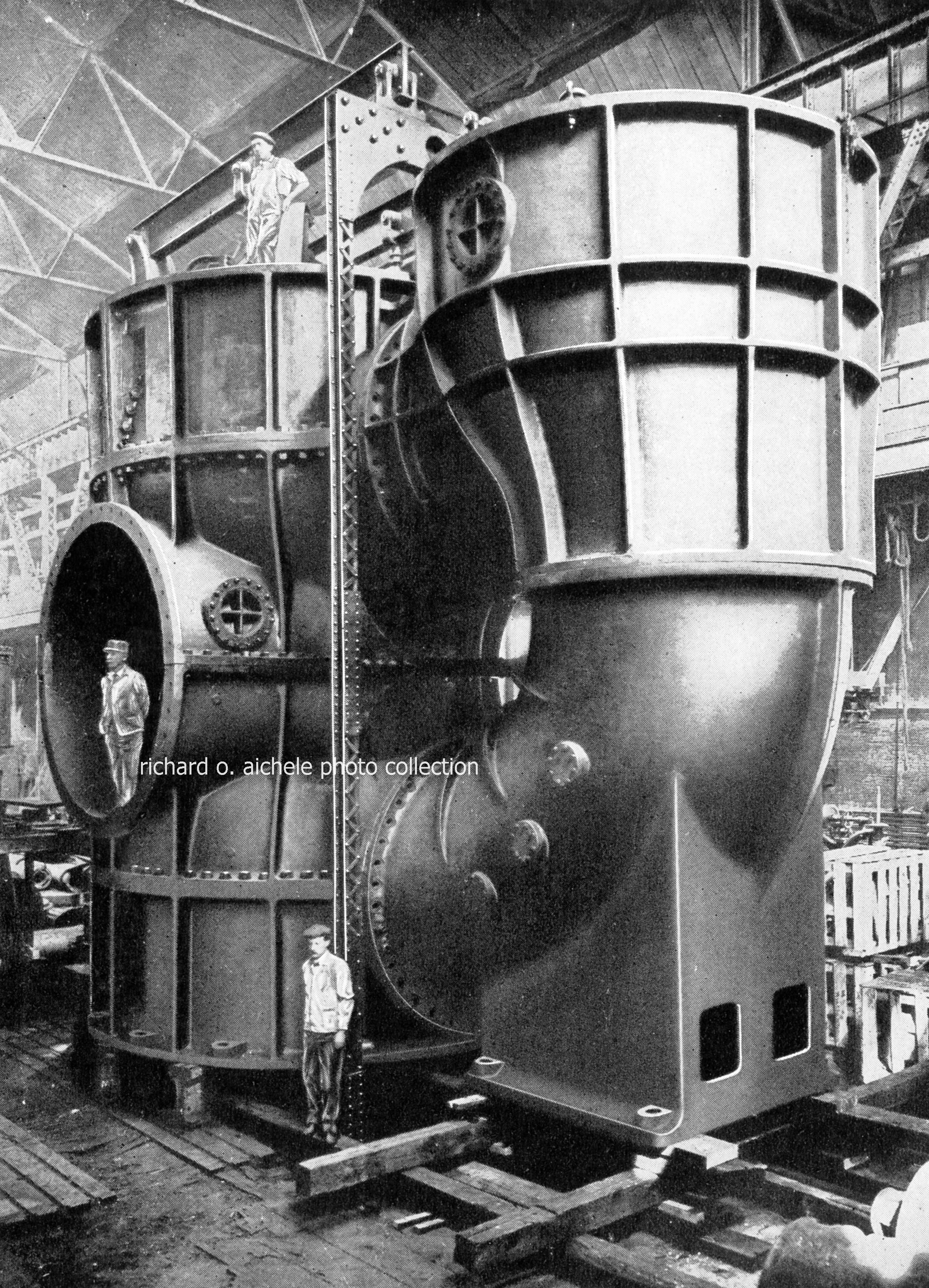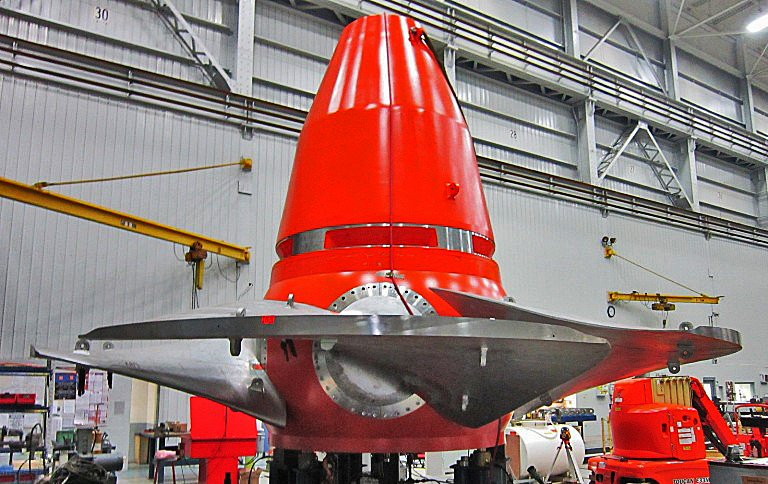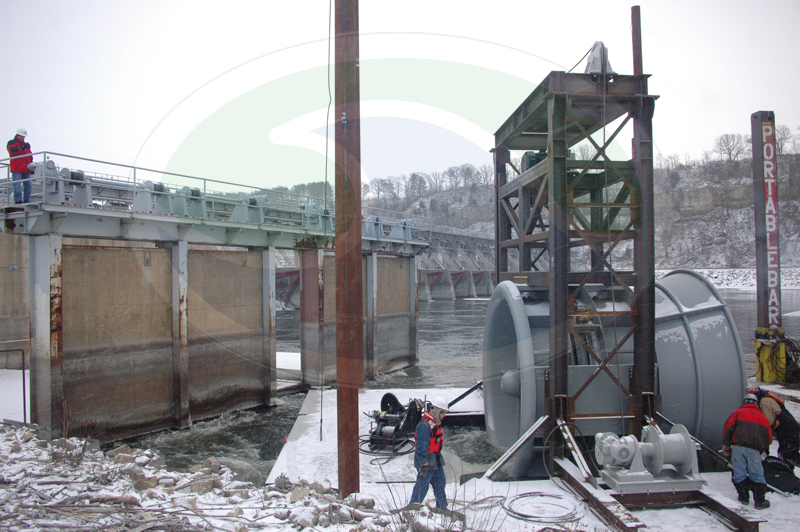Copyright 2020 by Richard O. Aichele - email rottoa@gmail.com - and Information Works Inc.
|
Hydro and Tidal Power Generation Progress |
|
This 13,000 Horsepower turbine was built in 1908 for the Electrical Development Company based in Ontario, Canada.
One of the early developers of hydro electric power at the Niagara River at Niagara Falls, Ontario was the Electrical Development Company. The company's hydro power plant began generating electrical power in 1906. The hydro plant collected Niagara River water above the falls that then flowed to the water turbines through 10.5 foot diameter penstocks. The water was returned to the Niagara River behind the fall's curtain of water after passing through a 2,000 foot long, 33 foot diameter tunnel under the river. |
|
|
€11 million ITEG project to integrate tidal power, grid and hydrogen |
"An €11 million Interreg North-West Europe (NWE) project has been launched in Orkney to develop an all-in-one solution for the generation of clean predictable energy, grid management, and the production of hydrogen from excess capacity. Led by the European Marine Energy Centre (EMEC) in Orkney, the €11m Integrating Tidal Energy into the European Grid (ITEG) project brings together partners from across the UK, France, Belgium and the Netherlands to address energy-related carbon emissions in North-West Europe and tackle grid export limitations faced in remote areas such as Orkney. The project consortium includes EMEC, Scotrenewables Tidal Power, AREVA H2Gen, the Energy Systems Catapult, Energy Valley/New Energy Coalition, University of Caen Normandy, University of Le Havre Normandy, Ghent University and the Normandy Development Agency. Funded by the Interreg NWE programme, part of the ERDF (European Regional Development Fund), the project will deliver an onshore energy management system at EMEC’s Fall of Warness tidal test site, off the northern Orkney island of Eday. This will support the production of hydrogen using an AREVA H2Gen electrolyser, the first to be deployed in the UK, which will be powered by Scotrenewables’ next generation 2MW floating tidal energy converter, the SR2-2000," according to Fuel Cell Works. News Sourch at: https://fuelcellsworks.com/news/11-million-iteg-project-to-integrate-tidal-power-grid-and-hydrogen |
|
|
Holtwood PPL's Pennsylvania Fish-Friendly Hydro Facility |
The 100 year old Holtswood facility’s infrastructure includes a 55-foot high dam spanning the Susquehanna River that created the 2,400 acre Aldred Lake now a popular recreational area and provided the hydro capability for a powerhouse with water turbines and generators producing 108 MW of electric power. The $440 million project included a new powerhouse containing two new 62.5 MW Voith Hydro Kaplan fish-friendly design turbines. The powerhouse was constructed on the site of the facilities’ former coal fired steam plant and has increased the facilities power out to 233 MW of non-fossil renewable Green power. Turbine technologies partially driven by environmental issues of protection of migratory fish in rivers have substantially advanced since the older turbines were state-of-the-art. In this case, the Susquehanna River where the Holtwood dam and hydro facility is located has historically been on the migratory fish passage for the American Shad that spawn in that river's upper fresh water reaches and later return to the Chesapeake Bay's salt waters. During the planning for the new turbines and re-licensing of the existing hydro Holtwood turbines, the impacts on the migratory fish were a major consideration by the utility, environmentalists, plus federal and state and regulators and influenced the licensing process.The new Voith Hydro turbines are representative of the fish-friendly technology advances still being planned by engineers and marine biologists only 15 years ago. One program was the U.S. Department of Energy's Advanced Hydropower Turbine Systems Program (AHTS) that provided funding and, coordination in addition to private sources and investments to redesign turbines to reduce stresses and physical damage to fish passing through a turbine's water paths. Resolving the technical challenges led to redesigns of turbine infrastructures to reduce or eliminate major areas that were the greatest threats to migratory fish. Those areas included the gaps between turbine blades and the hub, designs that produced cavitation in the turbine's water passes, rough turbine surfaces potentially causing fish injuries if impacted due to flow turbulences, and runner blades and stay vanes designs. Design solutions for new fish friendly Kaplan turbine designs now include elimination of gaps for hubs, blades and discharge rings, greaseless gate bushings and environmentally friendly lubricants. One example: A Minimum Gap Runner (MGR) design developed by Voith Hydro had sufficiently small gaps or no gaps between the turbine walls and runner to reduce the possibility of fish being caught there. At Holtswood, the result may well be that significantly more Shad will survive the migration from the sea to spawn in upper Susquehanna River areas. |
|
|
Apple's Hydro Electric Power Approach |
Apple Inc.uses low head hydroelectric generators to produce and supply electric power to Apple’s data center in Prineville, Oregon as part of Apple’s program “to power every facility at Apple entirely with energy from renewable sources -- solar, wind, hydro and geothermal" According to the Federal Energy Regulatory Commission (FERC), this hydroelectric facility generates 3 to 5 MW of electric power using irrigation water diverted by canals from the Deschutes River and Crooked River. At inception, this new hydroelectric plant was being built by EBD Hydro LLC under a 2012 grant of $1.5 million from the U.S. Department of Energy and the Department of the Interior. The 45-Mile Project is considered ideal for the CleanPower AS Turbinator technologies where “renewable hydropower energy can be harvested in many low head drops” especially in irrigation or water supply networks that “have predictable water flow,” according to CleanPower. Technologies developed by INPOWER AS were adapted for Turbinator designs to be applicable for small hydropower plants according to CleanPower. “We consider the U.S. market to be extremely interesting due to the vast resources available in the irrigation and water supply canals. A Turbinator is a sealed unit, Kaplan design fixed-blade axial flow turbine with only one rotating part and incorporates a direct drive synchronous permanent magnetized generator. According to the manufacturer, Turbinator’s can operate in a standard power range of 100 kW to 3,000 kW and achieve a total turbine + generator efficiency greater than 80 percent. With turbine design parameters ranging from 15 feet to 180 feet of head, the company noted Turbinator installations “do not need a power house which significantly reduces the civil works, capital investments and construction time.” |
|
|
Developing Low Profile Dam Hydro Power Opportunities |
The use of water power for manufacturing and electric power production is finally experiencing a renewal of interest in hydropower and new improvements to engineering concepts some of which are over 100 years old. Dams in the U.S. were built throughout the 19th and early 20th century not only for irrigation and navigation but primarily to power the water wheels and water turbines that powered the industrial revolution in the U.S. The industrial revolution's large factories and weaving mills were located along rivers to harness that water power. The shift to coal then oil fossil fuels to power steam boilers ended most smaller scale hydro although ultimately later at the human cost of increasing air pollution. |
Today, expanding the use of one of the largest renewable energy sources combined with an emphasis on reducing or eliminating environmental impacts on the ecosystem through innovative development of hydropower is a national goal according to Department of the Interior Secretary Ken Salazar. Already well into a $17 million, 3 year funding program for 16 projects in eleven states, the results are expected to help maximize the development of clean hydro power sources. One of the development targets it to increase use of existing dams which if fully developed "could provide an electrical generating capacity of more than 12 gigawatts [and that] amounts to increasing U.S. conventional hydrocapacity by roughly 15%," according to an Energy Department study. The study identified 54,000 specific non-powered dam sites "that could be developed to provide enough energy to power over four million households.
Not all hydropower systems use the traditional water flowing vertically over a dam but instead use the force of water moving laterally after having been impounded by dam like structures in highly efficient new technology power generation modes such as hydrokinetic turbines. Overall, the growth of the hydropower industry, advances in their technologies to utilize water power and industry consolidations to improve efficiencies is expanding. One recent example, Brookfield Renewable Energy Partners L.P. will acquire 19 existing hydroelectric stations and 8 upstream storage reservoir dams in Maine "with an aggregate capacity of 351 MW and expected average annual generation of approximately 1.6 million MW hours." That will be in addition to the 103 MW operating capacity Brookfield already has operational in the same area. Major obstacles in putting new electric generation capacity on line have been and remains the long lead times for engineering, financing and the final regulatory approvals process. However smaller hydropower electric generation can provide a viable option and as an Energy Department study concluded that, "Adding power to the existing dam structure can often be achieved at lower cost, with less risk, and in a shorter timeframe than a development requiring new dam construction." That results of these hydropower technology approaches and related technology approaches could, as another department study concluded that, "By 2030, 15% of the nation's electricity could come from water power including hydropower and marine hydrokinetic energy sources like waves and tides," and that, "expansion of new hydropower is achievable." |
|
|
Ocean Tidal Energy Power Generation Connected To The Grid |
Tidal electric power moved forward as a viable power when a source "with a rated capacity of 150 kilowatts that generates enough electricity annually to power 25 to 30 homes' according to the U.S. Office of Energy Efficiency and Renewable Energy (U.S. OEERE). Ocean Renewable Power Company said that its, "Cobscook Bay Tidal Energy Project with the help of Bangor Hydro Electric Company marked the first time that power from any ocean energy project -- including offshore wind, wave and tidal -- was delivered to the grid in the United States." |
The U.S. OEERE statement explained the project was part of the Refinement of Cross Flow Turbine Hydrofoils program. "Advanced water power technologies include devices capable of extracting electrical power from waves, water currents, and ocean thermal temperature differences. They also included technology advancements that would (1) enable cost-competitive development of new hydropower resources such as hydropower projects built on conduit or water conveyance systems, existing non-powered dams, or small-scale pumped storage projects, or (2) lead to improvements in the efficiency and/or environmental performance of existing hydropower and pumped storage facilities. In FY 2010, the U.S. Department of Energy's Office of Energy Efficiency and Renewable Energy funded research and development activities designed to accelerate the technology evolution of advanced water power. |
Solution: DOE STTR funding was used to refine the Ocean Renewable Power Company's (ORPC) TidGen™ Power System cross flow turbine foils. In 2012 the TidGen™ became the first commercial, grid-connected, hydrokinetic tidal energy project in North America. This is the only ocean energy project, other than one using a dam, which delivers power to a utility grid anywhere in North, Central, and South America. In late summer 2012, ORPC completed installation of the first TidGen™ Power System at the Cobscook Bay, ME, including a local on-shore station. This first TidGen™ device has a rated capacity of 150 kilowatts and generates enough electricity annually to power 25 to 30 homes. |
After running and monitoring the initial TidGen™ system for a year, ORPC will install additional power systems over the ensuing three years to increase the project's output to up to 5 megawatts - enough electricity to power 1,200 Maine homes and businesses with clean tidal energy. Since 2007, ORPC has invested more than $21 million into the Maine economy through spending in 13 of the state's 16 counties, and has created or retained more than 100 jobs statewide. This includes over $5 million spent locally and providing employment to more than three dozen contractors, as well as local spending on goods and services." |
|
|
China's First Tidal Power Unit Connected to Grid For One Year |
On June 1, 2018, "China's first tidal power station has been connected to the grid for a year, the longest stable use of the renewable energy, according to the developer. The 3.4 mega-watt generating unit built by Hangzhou Lin Dong Ocean Energy Technology Co. Ltd. in Zhoushan City, east China's Zhejiang Province, has sent over 800,000 kilowatt hours of electricity to the grid. Lin Dong, chief engineer and chair of the company, said on Thursday that when all turbines of the generating unit are installed in November, it will have an annual power output of 6 million kilowatt hours, enough for supplying electricity for 3,000 households annually. The previous record of tidal energy power generation was set in Britain with a four-month supply in 2015. He said the company is aiming at building a 15 mega-watt or 20 mega-watt power unit that can break even the cost, making the sustainable energy feasible. Lin is expecting foreign orders, with representatives from Canada and New Zealand interested." News source: http://www.xinhuanet.com/english/2018-06/01/c_137223146.htm |
Published by Information Works Inc., PO Box 4725, Saratoga Springs, NY 12866 USA www.inforworks.com |

 Hydro Power History.
Hydro Power History.
 Hydro electric generation on the East Coast took another step forward January, 2014. The PPL Holtswood hydro electric facility at full operation has an electric output from 108 MW to 233 MW plus is a major environmental advance for state efforts to improve the Susquehanna River’s seasonal fish spawning capabilities.
Hydro electric generation on the East Coast took another step forward January, 2014. The PPL Holtswood hydro electric facility at full operation has an electric output from 108 MW to 233 MW plus is a major environmental advance for state efforts to improve the Susquehanna River’s seasonal fish spawning capabilities. Construction at the Hastings, MN low-head hydropower dam site by Hydro Green Energy (HGE) was another example of maximizing the hydro electric production capabilities of low-head dams. Low-head dams of less than 30 feet drop that have been largely overlooked in the past 70 years offer a potential hydro growth area. Among the developers of new low-head power technologies, HGE said its "unique approach to hydropower project development will unlock scores of low-head hydropower sites that have been uneconomic to develop over the past several decades." The company's modular approach "simplifies installation and maintenance" while ensuring there is "no interference with existing operations of existing dams." According to HGE it, "is presently developing 28 hydropower projects in 14 states. The company's project pipeline will result in the development of nearly 300 MW of clean, renewable energy."
Construction at the Hastings, MN low-head hydropower dam site by Hydro Green Energy (HGE) was another example of maximizing the hydro electric production capabilities of low-head dams. Low-head dams of less than 30 feet drop that have been largely overlooked in the past 70 years offer a potential hydro growth area. Among the developers of new low-head power technologies, HGE said its "unique approach to hydropower project development will unlock scores of low-head hydropower sites that have been uneconomic to develop over the past several decades." The company's modular approach "simplifies installation and maintenance" while ensuring there is "no interference with existing operations of existing dams." According to HGE it, "is presently developing 28 hydropower projects in 14 states. The company's project pipeline will result in the development of nearly 300 MW of clean, renewable energy."